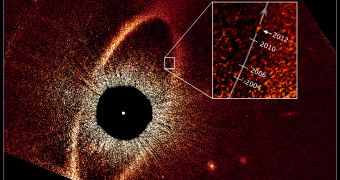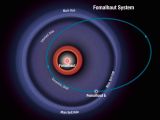Fomalhaut b, the exoplanet that only recently came back from the dead, the first to ever be seen in visible light, is getting stranger and stranger.
Scientists were very excited when they discovered it in 2008, but when they couldn't detect it in infrared light coupled with its very strange apparent orbit, they started believing it was just a short lived gas cloud.
But a couple of months ago, Fomalhaut b was declared a planet again. Now, further observation has revealed more insight into its eccentric orbit.
The 2,000-year journey takes the exoplanet from the very outskirts of its star to way beyond the dust cloud that encircles it.
Fomalhaut is a young star and surrounded by a huge dust and gas cloud. It's even bigger than first imagined, spanning to 20 billion miles, 32 billion km.
This was determined from the latest Hubble images which also provided more data on the orbit Fomalhaut b, the exoplanet circling the start.
Fomalhaut b, the first and so far the only exoplanet found around the star, comes in as close as 4.6 billion miles, 7.4 billion km, but goes as far out as 27 billion miles, 43 billion km.
For comparison, Pluto is 5.9 billion km from the sun, Voyager 1 is 18 billion km from the sun, almost outside of the solar system.
"We are shocked. This is not what we expected," Paul Kalas of the University of California at Berkeley and the SETI Institute said.
The strange orbit as well as clues from the dust cloud are strong indications that there are other planets around Fomalhaut, which is only 25 light years away from our planet.
One hypothesis is that another planet's gravitational influence pushed Fomalhaut b into its very eccentric orbit. A gap in the ice and dust belt around the star may be a sign of a planet orbiting in that region.
So far, no other planets have been detected around Fomalhaut, very reflective particles surrounding Fomalhaut b are what make it visible to Hubble.
The particles mostly originate from satellites orbiting the planet which would suffer extreme erosion in the thick dust cloud, similar to what happens on Saturn.
Fomalhaut b current orbit puts it into a collision course with a thicker part of the outer belt around the star, it's now traversing the gap.
Astronomers expect the planet to become even brighter as objects in the belt hit the planet and disintegrate. That will only happen if the planet is in a coplanar orbit with the dust ring.

 14 DAY TRIAL //
14 DAY TRIAL // 
